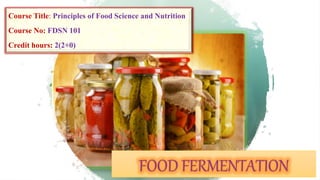This document provides information about fermentation processes used in food science and nutrition. It discusses various types of fermentation including alcoholic fermentation carried out by yeast and lactic acid fermentation carried out by lactic acid bacteria. Key microorganisms involved in different fermentations are described along with their uses in producing foods like yogurt, cheese, bread, wine and others. Fermentation pathways and conditions required for different microbes are also summarized.






















![• These are mostly pathogens
• Uses - Streptococcus thermophilus is a food
organism, with Lactobacillus delbrueckii ssp.
Bulgaricus used in the production of yoghurt.
• It is used in starter cultures for certain cheeses
[Parmesan]
Streptococcus:](https://image.slidesharecdn.com/fdsnlec17-210206091941/85/Fdsn-lec-17-23-320.jpg)


![• rod-shaped
• Present in- mucous membranes of the human[the oral cavity,] also found in
foodstuffs, such as plants, meats and milk products.
• Example- Lb. delbrueckii ssp. bulgaricus is a key starter organism for yoghurts
organism for yoghurts and some cheeses.
• lactobacilli involve in other fermentations, such as sourdough and fermented
sausages, for example, salami
• Disadvantage - they can spoil beer and either fresh or cooked meats, etc.
Lactobacillus](https://image.slidesharecdn.com/fdsnlec17-210206091941/85/Fdsn-lec-17-26-320.jpg)

![• Lactococcus lactis is a species of great significance in the
fermentation of milk products.
• TYPE-Gram-positive organisms
• SHAPE- rod-shaped, cocci (spherical) or coccobacilli.
• TEMPERATURE - mesophilic, [but some can grow at
temperatures (4◦C) and as high as 45◦C.
• pH - 4.0–4.5, [but certain strains can tolerate and grow at
as low as 3.2]
Lactococcus](https://image.slidesharecdn.com/fdsnlec17-210206091941/85/Fdsn-lec-17-28-320.jpg)











